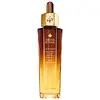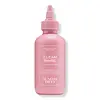What's inside
What's inside
 Key Ingredients
Key Ingredients

 Benefits
Benefits

 Concerns
Concerns

 Ingredients Side-by-side
Ingredients Side-by-side

Water
Skin ConditioningPropanediol
SolventButylene Glycol
HumectantPentylene Glycol
Skin ConditioningGlycerin
HumectantRoyal Jelly
Mel
EmollientPPG-26-Buteth-26
Skin ConditioningSaccharide Isomerate
HumectantPanthenol
Skin ConditioningZinc PCA
HumectantPEG-40 Hydrogenated Castor Oil
EmulsifyingChlorphenesin
AntimicrobialPolyquaternium-51
Skin ConditioningFructose
HumectantMaltodextrin
AbsorbentCassia Alata Leaf Extract
AstringentXanthan Gum
EmulsifyingParfum
MaskingAesculus Hippocastanum Extract
AntioxidantSaccharomyces Cerevisiae Extract
Skin ConditioningSimmondsia Chinensis Seed Oil
EmollientCitric Acid
BufferingSodium Citrate
BufferingTocopherol
Antioxidant1,2-Hexanediol
Skin ConditioningCaprylyl Glycol
EmollientPotassium Sorbate
PreservativeWater, Propanediol, Butylene Glycol, Pentylene Glycol, Glycerin, Royal Jelly, Mel, PPG-26-Buteth-26, Saccharide Isomerate, Panthenol, Zinc PCA, PEG-40 Hydrogenated Castor Oil, Chlorphenesin, Polyquaternium-51, Fructose, Maltodextrin, Cassia Alata Leaf Extract, Xanthan Gum, Parfum, Aesculus Hippocastanum Extract, Saccharomyces Cerevisiae Extract, Simmondsia Chinensis Seed Oil, Citric Acid, Sodium Citrate, Tocopherol, 1,2-Hexanediol, Caprylyl Glycol, Potassium Sorbate
Water
Skin ConditioningPropanediol
SolventGlycolipids
Skin ConditioningPEG-7 Glyceryl Cocoate
EmulsifyingHydroxyethyl Acrylate/Sodium Acryloyldimethyl Taurate Copolymer
Emulsion StabilisingQuaternium-80
Polysorbate 20
EmulsifyingZinc PCA
HumectantKaolin
AbrasiveMenthyl Nicotinate
HumectantGlycolic Acid
BufferingCocamidopropyl Dimethylamine
EmulsifyingPentylene Glycol
Skin ConditioningUrea
BufferingNiacinamide
SmoothingLinoleic Acid
CleansingLinolenic Acid
CleansingHamamelis Virginiana Water
AstringentSodium Lactate
BufferingSodium PCA
HumectantPanthenol
Skin ConditioningPropylene Glycol
HumectantSalicylic Acid
MaskingCI 77891
Cosmetic ColorantSodium Starch Octenylsuccinate
AbsorbentCalcium Pantothenate
Maltodextrin
AbsorbentSodium Benzoate
MaskingJasminum Sambac Flower Extract
MaskingPotassium Sorbate
PreservativeSodium Phytate
Sodium Ascorbyl Phosphate
AntioxidantRosa Damascena Flower Extract
MaskingTocopheryl Acetate
AntioxidantPyridoxine Hcl
Skin ConditioningAlcohol
AntimicrobialGlycine
BufferingFructose
HumectantInositol
HumectantLactic Acid
BufferingBisabolol
MaskingSilica
AbrasiveSynthetic Fluorphlogopite
Water, Propanediol, Glycolipids, PEG-7 Glyceryl Cocoate, Hydroxyethyl Acrylate/Sodium Acryloyldimethyl Taurate Copolymer, Quaternium-80, Polysorbate 20, Zinc PCA, Kaolin, Menthyl Nicotinate, Glycolic Acid, Cocamidopropyl Dimethylamine, Pentylene Glycol, Urea, Niacinamide, Linoleic Acid, Linolenic Acid, Hamamelis Virginiana Water, Sodium Lactate, Sodium PCA, Panthenol, Propylene Glycol, Salicylic Acid, CI 77891, Sodium Starch Octenylsuccinate, Calcium Pantothenate, Maltodextrin, Sodium Benzoate, Jasminum Sambac Flower Extract, Potassium Sorbate, Sodium Phytate, Sodium Ascorbyl Phosphate, Rosa Damascena Flower Extract, Tocopheryl Acetate, Pyridoxine Hcl, Alcohol, Glycine, Fructose, Inositol, Lactic Acid, Bisabolol, Silica, Synthetic Fluorphlogopite
Ingredients Explained
These ingredients are found in both products.
Ingredients higher up in an ingredient list are typically present in a larger amount.
Maltodextrin is a polysaccharide. It is derived from starch such as rice, corn, wheat, or potato starch.
In food, Maltodextrin is used to improve the texture and thicken a product. Due to its structure, it can help create a gel texture. As an emulsion stabilizer, it helps keep the ingredients in a product together.
As a polysaccharide, Maltodextrin has moisturizing properties. Polysaccharides are a type of carbohydrate. The top layer of skin uses polysaccharides to retain water, keeping the skin hydrated.
Maltodextrin is water soluble and has a sweet taste.
Learn more about MaltodextrinPanthenol is a common ingredient that helps hydrate and soothe the skin. It is found naturally in our skin and hair.
There are two forms of panthenol: D and L.
D-panthenol is also known as dexpanthenol. Most cosmetics use dexpanthenol or a mixture of D and L-panthenol.
Panthenol is famous due to its ability to go deeper into the skin's layers. Using this ingredient has numerous pros (and no cons):
Like hyaluronic acid, panthenol is a humectant. Humectants are able to bind and hold large amounts of water to keep skin hydrated.
This ingredient works well for wound healing. It works by increasing tissue in the wound and helps close open wounds.
Once oxidized, panthenol converts to pantothenic acid. Panthothenic acid is found in all living cells.
This ingredient is also referred to as pro-vitamin B5.
Learn more about PanthenolPentylene glycol is typically used within a product to thicken it. It also adds a smooth, soft, and moisturizing feel to the product. It is naturally found in plants such as sugar beets.
The hydrophilic trait of Pentylene Glycol makes it a humectant. As a humectant, Pentylene Glycol helps draw moisture from the air to your skin. This can help keep your skin hydrated.
This property also makes Pentylene Glycol a great texture enhancer. It can also help thicken or stabilize a product.
Pentylene Glycol also acts as a mild preservative and helps to keep a product microbe-free.
Some people may experience mild eye and skin irritation from Pentylene Glycol. We always recommend speaking with a professional about using this ingredient in your routine.
Pentylene Glycol has a low molecular weight and is part of the 1,2-glycol family.
Learn more about Pentylene GlycolPotassium Sorbate is a preservative used to prevent yeast and mold in products. It is commonly found in both cosmetic and food products.
This ingredient comes from potassium salt derived from sorbic acid. Sorbic acid is a natural antibiotic and effective against fungus.
Both potassium sorbate and sorbic acid can be found in baked goods, cheeses, dried meats, dried fruit, ice cream, pickles, wine, yogurt, and more.
You'll often find this ingredient used with other preservatives.
Learn more about Potassium SorbatePropanediol is an all-star ingredient. It softens, hydrates, and smooths the skin.
It’s often used to:
Propanediol is not likely to cause sensitivity and considered safe to use. It is derived from corn or petroleum with a clear color and no scent.
Learn more about PropanediolWater. It's the most common cosmetic ingredient of all. You'll usually see it at the top of ingredient lists, meaning that it makes up the largest part of the product.
So why is it so popular? Water most often acts as a solvent - this means that it helps dissolve other ingredients into the formulation.
You'll also recognize water as that liquid we all need to stay alive. If you see this, drink a glass of water. Stay hydrated!
Learn more about WaterZinc PCA (or "zinc salt") differs slightly from zinc itself. PCA stands for pyrrolidone carboxylic acid. However, Zinc PCA comes from zinc.
It can help reduce redness, regulate sebum, and promote the general healing process of the skin.
Zinc PCA tends to be especially useful for those with oily, acne-prone skin. It's certainly an ingredient worth trying out!
Learn more about Zinc PCA